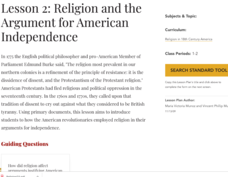National Endowment for the Humanities
Lesson 2: Religion and the Argument for American Independence
Young scholars examine how religion affected arguments justifying American independence. They read and analyze primary source documents, and write an essay analyzing how Americans used religious arguments to justify revolution against a...
Annenberg Foundation
Utopian Promise
Scholars learn all about the Puritans in the third installment of a 16-part lesson series. After watching a video, they read and discuss biographies of Puritans and Quakers from American history, write journal entries and poetry, and...
American Sign Language University
ASL Interactive
Go over the building blocks of American Sign Language with an interactive alphabet tool. As learners of all ages hover their cursors over a letter, the image of a hand changes to reflect that letter's sign in ASL.
Curated OER
5th Grade Historical Fiction: Solder's Letter
A picture is worth a thousand words, but sometimes a single word can go a long way as well. Practice making inferences about character traits with a letter written from the perspective of a soldier in the American Revolution.
PACER Center
Notifying the School About a Bullying Incident—Using a Template Letter
A pre-made letter is ideal for parents to use if their child is being bullied. The template comes with a brief overview for implementation, as well as two separate 504 and IEP templates to address bullying instances. Use the...
New York State Education Department
US History and Government Examination: August 2011
Using primary source documents, pupils consider how the United States' democratic story has evolved over time. A second essay question examines the role of geography in history, and multiple-choice questions sharpen test-taking skills.
National Endowment for the Humanities
Victory and the New Order in Europe
A New Order in Europe calls for a new lesson plan! This third plan in a series of four sequential lessons encourages high schoolers to read primary sources about the development of the New Order and follow up their knowledge with a...
Santillana USA
Celebra Kwanzaa
¡Celebramos Kwanzaa! Celebrate Kwanzaa through the fictional story Celebra Kwanzaa con Botitas y sus gatitos to delightfully explain the seven principles of Kwanzaa. Dual language learners participate in reading and vocabulary...
Curated OER
What is Meant by Returning to Fundamental Principles?
What did the Founding Fathers mean by the importance of continually returning to fundamental principles? Your young historians will analyze a series of quotations illustrating the fundamental ideals and principles of the...
California Department of Education
My Dream Career
Is your job a dream come true? Career seekers research to discover what their ideal jobs might be in the second of five career and college readiness lessons for sixth graders. After determining their occupational clusters, individuals...
Department of Defense
Do Dea: Ap Us History: Unit 10: Understanding American History
This extensive learning module looks at how themes of American history can create a better understanding of the big picture of the nation's history.
CommonLit
Common Lit: Book Pairings: "Death of a Salesman" by Arthur Miller
In this play, Willy Loman, an aging traveling salesman, struggles to come to terms with his "failures," reconnect with his sons, and let go of the ideal of the American Dream. Selected (9) reading passages (grades 8-12) to pair with...
The Dirksen Congressional Center
Congress for Kids: Independence: Quiz 1
Take this four-question quiz to see how much you know about the United States Constitution.
The Dirksen Congressional Center
Congress for Kids: Independence: Quiz 2
Take this four-question quiz to test your knowledge about the United States Constitution.
The Dirksen Congressional Center
Congress for Kids: Independence: Quiz 3
Take this four-question quiz to see how much you know about the United States Constitution.
Khan Academy
Khan Academy: Us History: 1754 1800: Unit Test
Take this eleven question unit test over US history during the period of 1754 and 1800.















